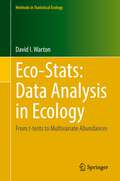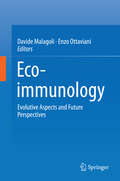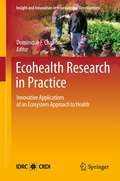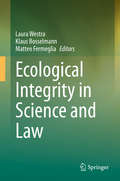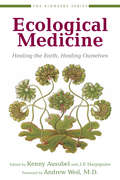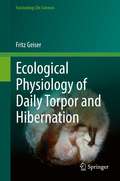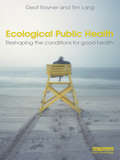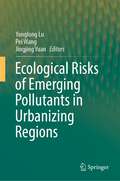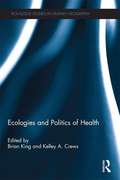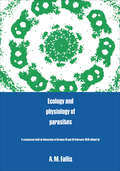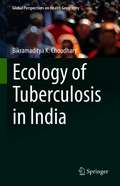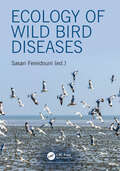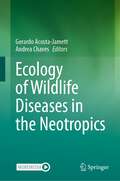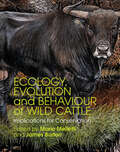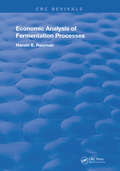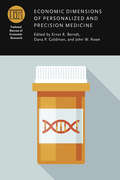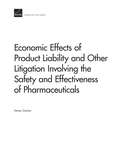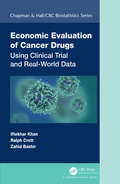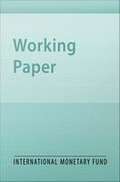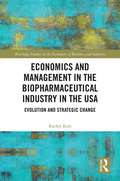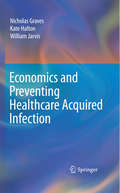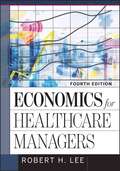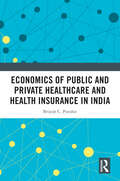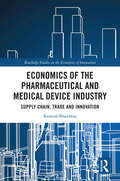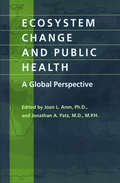- Table View
- List View
Eco-Stats: From t-tests to Multivariate Abundances (Methods in Statistical Ecology)
by David I WartonThis book introduces ecologists to the wonderful world of modern tools for data analysis, especially multivariate analysis. For biologists with relatively little prior knowledge of statistics, it introduces a modern, advanced approach to data analysis in an intuitive and accessible way. The book begins by reviewing some core principles in statistics, and relates common methods to the linear model, a general framework for modeling data where the response is continuous. This is then extended to discrete data using generalized linear models, to designs with multiple sampling levels via mixed models, and to situations where there are multiple response variables via model-based approaches to multivariate analysis. Along the way there is an introduction to: important principles in model selection; adaptations of the model to handle non-linearity and cyclical variables; dependence due to structured correlation in time, space or phylogeny; and design-based techniques for inference that can relax some of the modelling assumptions. It concludes with a range of advanced topics in model-based multivariate analysis relevant to the modern ecologist, including fourth corner, latent variable and copula models. Examples span a variety of applications including environmental monitoring, species distribution modeling, global-scale surveys of plant traits, and small field experiments on biological controls. Math Boxes throughout the book explain some of the core ideas mathematically for readers who want to delve deeper, and R code is used throughout. Accompanying code, data, and solutions to exercises can be found in the ecostats R package on CRAN.
Eco-immunology
by Davide Malagoli Enzo OttavianiThis book represents a cutting-edge contribution giving an all-around perspective of eco-immunology today. Beside questions of the utmost importance for the whole community of immunologists, e. g, the intrinsic limits of immunological experiments performed at the bench on a limited number of selected models, the book covers several other facets of the eco-immunological approach, including host-parasite interactions, human aging and population immunology. Throughout the book the importance of population dynamics and evolutionary diversification of immune systems is frequently recalled, and makes the reader aware of the basic similarities and differences existing between humans and the models adopted for studying human immune system. The evidenced differences have been recently challenging the reliability of several established animal models and in the book it is discussed for the first time in analytical terms whether mice are reliable models of human inflammatory disorders.
Ecohealth Research in Practice
by Dominique F. CharronThis book is about doing innovative research to achieve sustainable and equitable change in people's health and well-being through improved interactions with the environment. It presents experiences from the field of ecosystem approaches to health (or ecohealth research) and some insights and lessons learned. It builds on previous literature, notably Forget (1997), Forget and Lebel (2001), Lebel (2003), and Waltner-Toews et al. (2008). Through case-studies and other contributions by researchers supported by Canada's International Development Research Centre (IDRC), the book presents evidence of real changes in conditions of people, their health, and the ecosystems that support them. These changes were derived from applications of an ecosystem approach to health in developing regions of the world. The book also illustrates the resulting body of applied, participatory, and action research that improved health and environmental management in developing countries and, in many cases, influenced policies and practices.
Ecological Integrity in Science and Law: Science, Ethics And The Law (Routledge Research In International Environmental Law Ser.)
by Laura Westra Klaus Bosselmann Matteo FermegliaThis book offers recent insights into some of the burning issues of our times: climate change, exposure to chemicals, refugee issues and the ecological harm that accompanies conflict situations. It brings together a group of pioneering scholars, mostly legal experts but also thinkers from various scientific disciplines, to discuss concerns from around the globe – from Australia and New Zealand, to Canada and the United States, European countries including Germany, Italy, Britain and the Czech Republic, as well as the African continent. Presenting the latest climate and ecology-related case law, as well as analyses of the conceptual issues that underlie international problems, it covers the extinction of species, the basic role of women and Indigenous peoples in protecting the environment, the failure of today’s states to protect the human right to a safe environment and public health, the harm arising from industrial food production, and the problems resulting from a growth-oriented economy. Lastly, the book examines various international legal principles and regulations that have been proposed to defend global ecological rights.
Ecological Medicine
by Andrew Weil Kenny Ausubel J. P. HarpigniesDrawn largely from presentations given at the annual Bioneers Conference, this pathfinding book-the first in Sierra Club Books' new Bioneers Series-focuses on pragmatic solutions emerging at the fertile edges between the overlapping worlds of environmental restoration and holistic healing. In this kaleidoscopic collection, many of the world's leading health visionaries show us how human health is inescapably dependent on the health of our environment.The rich array of voices in this book reflects the collective intelligence of the emerging movement known as Ecological Medicine. Its advocates look to the strategic public health measures that, first, do no harm to the environment and, in turn, successfully improve human health. They call for prevention and precaution as the first line of action. They seek to heal the tragic split between conventional medicine and nature and to conjure nature's own mysterious capacity for self-repair. They celebrate the virtues of ancient natural-medicine practices but also embrace an integrative medicine that uses the best of all approaches to healing-with special emphasis on the centrality of the human spirit in the healing process. Their inspiring work, described so compellingly in this book, is of critical relevance to everyone concerned about health and the environment.
Ecological Physiology of Daily Torpor and Hibernation (Fascinating Life Sciences)
by Fritz GeiserThis book provides an in-depth overview on the functional ecology of daily torpor and hibernation in endothermic mammals and birds. The reader is well introduced to the physiology and thermal energetics of endothermy and underlying different types of torpor. Furthermore, evolution of endothermy as well as reproduction and survival strategies of heterothermic animals in a changing environment are discussed.Endothermic mammals and birds can use internal heat production fueled by ingested food to maintain a high body temperature. As food in the wild is not always available, many birds and mammals periodically abandon energetically costly homeothermic thermoregulation and enter an energy-conserving state of torpor, which is the topic of this book. Daily torpor and hibernation (multiday torpor) in these heterothermic endotherms are the most effective means for energy conservation available to endotherms and are characterized by pronounced temporal and controlled reductions in body temperature, energy expenditure, water loss, and other physiological functions. Hibernators express multiday torpor predominately throughout winter, which substantially enhances winter survival. In contrast, daily heterotherms use daily torpor lasting for several hours usually during the rest phase, some throughout the year. Although torpor is still widely considered to be a specific adaptation of a few cold-climate species, it is used by many animals from all climate zones, including the tropics, and is highly diverse with about 25-50% of all mammals, but fewer birds, estimated to use it. While energy conservation during adverse conditions is an important function of torpor, it is also employed to permit or facilitate energy-demanding processes such as reproduction and growth, especially when food supply is limited. Even migrating birds enter torpor to conserve energy for the next stage of migration, whereas bats may use it to deal with heat. Even though many heterothermic species will be challenged by anthropogenic influences such as habitat destruction, introduced species, novel pathogens and specifically global warming, not all are likely to be affected in the same way. In fact it appears that opportunistic heterotherms because of their highly flexible energy requirements, ability to limit foraging and reduce the risk of predation, and often pronounced longevity, may be better equipped to deal with anthropogenic challenges than homeotherms. In contrast strongly seasonal hibernators, especially those restricted to mountain tops, and those that have to deal with new diseases that are difficult to combat at low body temperatures, are likely to be adversely affected. This book addresses researchers and advanced students in Zoology, Ecology and Veterinary Sciences.
Ecological Public Health: Reshaping the Conditions for Good Health
by Tim Lang Geof RaynerWhat is public health? To some, it is about drains, water, food and housing, all requiring engineering and expert management. To others, it is the State using medicine or health education and tackling unhealthy lifestyles. This book argues that public health thinking needs an overhaul, a return to and modernisation around ecological principles. Ecological Public Health thinking, outlined here, fits the twenty-first century’s challenges. It integrates what the authors call the four dimensions of existence: the material, biological, social and cultural aspects of life. Public health becomes the task of transforming the relationship between people, their circumstances and the biological world of nature and bodies. For Geof Rayner and Tim Lang, this is about facing a number of long-term transitions, some well recognized, others not. These transitions are Demographic, Epidemiological, Urban, Energy, Economic, Nutrition, Biological, Cultural and Democracy itself. The authors argue that identifying large scale transitions such as these refocuses public health actions onto the conditions on which human and eco-systems health interact. Making their case, Rayner and Lang map past confusions in public health images, definitions and models. This is an optimistic book, arguing public health can be rescued from its current dilemmas and frustrations. This century’s agenda is unavoidably complex, however, and requires stronger and more daring combinations of interdisciplinary work, movements and professions locally, nationally and globally. Outlining these in the concluding section, the book charts a positive and reinvigorated institutional purpose.
Ecological Risks of Emerging Pollutants in Urbanizing Regions
by Pei Wang Yonglong Lu Jingjing YuanThis book characterizes the major pollution patterns of emerging contaminants, such as sources, emission effluents, temporal and spatial distributions, multi-media transportation and transformation processes, exposure pathways to ecosystems and humans, and ecological risks. Based on this, it establishes an urbanizing region management concept and highlights how urbanization and its regional ecology have evolved into a more integrated vision. It also decouples the relations between urbanization and emissions of emerging pollutants that are framed within a broad socio-ecological context considering institutions, policies, and governance. All the theory, methods, and case studies have been taken from the authors’ publications, which have undergone rigorous international peer review. The book presents the spatial distribution, pathways, and flow diagrams of the pollutants as well as the interactions between urbanization and regional pollution and includes detailed figures and pictures. It also investigates ecological risk characterization and expression using maps based on geographic information systems to illustrate the general profile and the spatial variation of risks. The book is a valuable resource for postgraduates, researchers, academics, environmental NGOs, and regional managers such as urban planners, environmental agency staff, legal regulators, and decision makers. Bridging the gap between environmental science and policy, it offers interdisciplinary theory, approaches, and case studies that facilitate applications of frontier science in ecology and environmental science to regional social and economic development.
Ecologies and Politics of Health: Ecologies And Politics Of Health (Routledge Studies in Human Geography)
by Brian King Kelley A. CrewsHuman health exists at the interface of environment and society. Decades of work by researchers, practitioners, and policy-makers has shown that health is shaped by a myriad of factors, including the biophysical environment, climate, political economy, gender, social networks, culture, and infrastructure. Yet while there is emerging interest within the natural and social sciences on the social and ecological dimensions of human disease and health, there have been few studies that address them in an integrated manner. Ecologies and Politics of Health brings together contributions from the natural and social sciences to examine three key themes: the ecological dimensions of health and vulnerability, the socio-political dimensions of human health, and the intersections between the ecological and social dimensions of health. The thirteen case study chapters collectively present results from Africa, Asia, Latin America, the United States, Australia, and global cities. Section one interrogates the utility of several theoretical frameworks and conventions for understanding health within complex social and ecological systems. Section two concentrates upon empirically grounded and quantitative work that collectively redefines health in a more expansive way that extends beyond the absence of disease. Section three examines the role of the state and management interventions through historically rich approaches centering on both disease- and non-disease-related examples from Latin America, Eastern Africa, and the United States. Finally, Section four highlights how health vulnerabilities are differentially constructed with concomitant impacts for disease management and policy interventions. This timely volume advances knowledge on health-environment interactions, disease vulnerabilities, global development, and political ecology. It offers theoretical and methodological contributions which will be a valuable resource for researchers and practitioners in geography, public health, biology, anthropology, sociology, and ecology.
Ecology and Physiology of Parasites: A Symposium
by A. Murray FallisIncreasing wisdom and ingenuity are required if we are to master our environment and cope with the myriad of organisms that affect our existence. Not the least of these organisms are the parasites and pathogens which can be found in all animals. The ecological implications of parasitism are obvious, and the interrelationships among different organisms within the same host are fascinating, but more knowledge and understanding are needed. The symposium are held to stimulate discussion of the significance of ecological problems presented by parasites and to develop means of attacking some of these problems. The diversity of parasitism from protozoa to anthropods was emphasized and the speakers and topics were selected to interest those in various biological disciplines and professions. Organized by the Department of Parasitology in the School of Hygiene of the University of Toronto, and held at Toronto in February 1970, the symposium was an unqualified success. The enthusiastic interest, indicated by the attendance of over three hundred people from seven countries, and numerous requests for copies of the proceedings led to the publication in this volume of the twelve papers presented at the symposium. The opening remarks of the leader of the discussion which follow each paper have been included and a complete bibliography is provided for each topic. The contributors are leading specialists in their fields; their papers present the results of the most recent research and assemble and review the scattered literature on each topic. The text is illustrated throughout with diagrams and photographs. Parasitism and associated phenomena are excellent examples of problems requiring the interdisciplinary approach taken by the symposium. The results of such an approach are useful in a wide variety of disciplines: microbiology, invertebrate zoology, entomology, and tropical medicine, as well as parasitology.
Ecology of Tuberculosis in India (Global Perspectives on Health Geography)
by Bikramaditya K. ChoudharyThe book addresses the issue of disease diffusion across the geographical span of India during the colonial period. Based on archival records, it analyses colonial economic policies and their implications for the spread of the disease across different regions of India as well as the role of the military in disease spread. It adds a new dimension to the understanding of the spread of TB in colonial India.The book also discusses the concept of the meaning of illness for different cohorts of TB patients. Based on narratives, it brings to readers the social and cultural dimensions that are responsible for the prevalence of the disease, despite having vaccination and medication available for more than half a century.The book will be beneficial to health and medical geographers and will bring new insights in historical geography as well as the history of medicine, by incorporating policy changes and their implication in disease spread. Sociologists and public health professionals will find narratives of patients interesting and useful for furthering their understanding.
Ecology of Wild Bird Diseases
by Sasan FereidouniThe book focuses on the ecology of the most important infectious diseases of wild avian hosts, especially those with high morbidity and mortality rates. Disease ecology is an important scientific approach to study the relationships and interactions between living organisms, their environment, and potential pathogens. Birds have high diversity, and the very special ability to fly and migrate. They migrate over long distances, and share ecosystems with other animals, even humans. They serve as the most important natural source of several pathogens with zoonotic potential. Bird-pathogen interactions are increasingly changing due to the continuous anthropogenic disturbances in habitats and ecosystems. With intensified climate change and improved environmental conditions for vectors, as well as higher susceptibility of avian hosts due to simultaneous exposure to environmental stressors (e.g., contamination, food limitation, etc.), the probability of emerging new infections and their expansion into new territories increase tremendously. The Covid-19 pandemic has shown that neglected ecological and epidemiological interactions between wildlife, domestic animals and humans are paramount to global health.The book has a different approach to understanding complex and multiscale interactions among various ecological factors for the most important infectious diseases of wild birds. It provides valuable data to students and everyone who deals with avian species including biologists, researchers, conservationists, and policymakers.
Ecology of Wildlife Diseases in the Neotropics
by Gerardo Acosta-Jamett Andrea ChavesThis contributed volume focuses on the Neotropical region, and explores the environmental, ecological and socio-economic components that facilitate the emergence of zoonotic diseases. This book highlights the primary ecological, environmental, social, and economic variables associated with the risk of maintenance, transmission, and dissemination of emerging, re-emerging, and neglected infectious diseases, in which Neotropical vertebrates are involved. It compiles up-to-date knowledge and research for the neotropical region, as well as discusses the current needs of knowledge improvement. The chapters include various examples of the cycles of infectious diseases, all with world-wide relevance where neotropical wild vertebrates are affected or involved.
Ecology, Evolution and Behaviour of Wild Cattle
by Mario Melletti James BurtonCovering all 13 species of wild cattle, Ecology, Evolution and Behaviour of Wild Cattle brings together the contributions of international leading experts on the biology, evolution, conservation status and management of the tribe Bovini, providing: - A comprehensive review of current knowledge on systematic, anatomy and ecology of all wild cattle species (chapters 1 to 8); - A clear understanding of the conservation status of each species and the gaps in our current knowledge (chapters 9 to 20); - A number of case studies on conservation activities and an investigation of some of the most threatened and poorly understood species (chapters 21 to 27). An invaluable resource for students, researchers, and professionals in behavioural ecology, evolutionary biology and conservation biology, this beautifully illustrated reference work reveals the extraordinary link between wild cattle and humans, the benefits some of these species have brought us, and their key roles in their natural ecosystems.
Economic Analysis of Fermentation Processes (Routledge Revivals)
by Harold B. ReismanPublished in 1988: It is the purpose of this book to outline and detail the many steps which are involved in bringing a fermentation product to market.
Economic Dimensions of Personalized and Precision Medicine (National Bureau of Economic Research Conference Report)
by John Rowe Ernst R. Berndt Dana P. GoldmanPersonalized and precision medicine (PPM)—the targeting of therapies according to an individual’s genetic, environmental, or lifestyle characteristics—is becoming an increasingly important approach in health care treatment and prevention. The advancement of PPM is a challenge in traditional clinical, reimbursement, and regulatory landscapes because it is costly to develop and introduces a wide range of scientific, clinical, ethical, and socioeconomic issues. PPM raises a multitude of economic issues, including how information on accurate diagnosis and treatment success will be disseminated and who will bear the cost; changes to physician training to incorporate genetics, probability and statistics, and economic considerations; questions about whether the benefits of PPM will be confined to developed countries or will diffuse to emerging economies with less developed health care systems; the effects of patient heterogeneity on cost-effectiveness analysis; and opportunities for PPM’s growth beyond treatment of acute illness, such as prevention and reversal of chronic conditions. This volume explores the intersection of the scientific, clinical, and economic factors affecting the development of PPM, including its effects on the drug pipeline, on reimbursement of PPM diagnostics and treatments, and on funding of the requisite underlying research; and it examines recent empirical applications of PPM.
Economic Effects of Product Liability and Other Litigation Involving the Safety and Effectiveness of Pharmaceuticals
by Steven GarberLiability effects on the economic performance of the pharmaceutical industry play a prominent role in the debate about the economic effects of product liability in the United States. The author analyzes incentive effects on company decisions, implications for economic outcomes such as drug safety and effectiveness, and suggests how public policy changes could mitigate liability-based sources of inefficient decisions of pharmaceutical companies.
Economic Evaluation of Cancer Drugs: Using Clinical Trial and Real-World Data (Chapman & Hall/CRC Biostatistics Series)
by Iftekhar Khan Ralph Crott Zahid BashirCancer is a major healthcare burden across the world and impacts not only the people diagnosed with various cancers but also their families, carers, and healthcare systems. With advances in the diagnosis and treatment, more people are diagnosed early and receive treatments for a disease where few treatments options were previously available. As a result, the survival of patients with cancer has steadily improved and, in most cases, patients who are not cured may receive multiple lines of treatment, often with financial consequences for the patients, insurers and healthcare systems. Although many books exist that address economic evaluation, Economic Evaluation of Cancer Drugs using Clinical Trial and Real World Data is the first unified text that specifically addresses the economic evaluation of cancer drugs. The authors discuss how to perform cost-effectiveness analyses while emphasising the strategic importance of designing cost-effectiveness into cancer trials and building robust economic evaluation models that have a higher chance of reimbursement if truly cost-effective. They cover the use of real-world data using cancer registries and discuss how such data can support or complement clinical trials with limited follow up. Lessons learned from failed reimbursement attempts, factors predictive of successful reimbursement and the different payer requirements across major countries including US, Australia, Canada, UK, Germany, France and Italy are also discussed. The book includes many detailed practical examples, case studies and thought-provoking exercises for use in classroom and seminar discussions. Iftekhar Khan is a medical statistician and health economist and a lead statistician at Oxford Unviersity’s Center for Statistics in Medicine. Professor Khan is also a Senior Research Fellow in Health Economics at University of Warwick and is a Senior Statistical Assessor within the Licensing Division of the UK Medicine and Health Regulation Agency. Ralph Crott is a former professor in Pharmacoeconomics at the University of Montreal in Quebec, Canada and former head of the EORTC Health Economics Unit and former senior health economist at the Belgian HTA organization. Zahid Bashir has over twelve years experience working in the pharmaceutical industry in medical affairs and oncology drug development where he is involved in the design and execution of oncology clinical trials and development of reimbursement dossiers for HTA submission.
Economic Transition and Health Care Reform: The Experience of Europe and Central Asia
by Adam LeiveA report from the International Monetary Fund.
Economics and Management in the Biopharmaceutical Industry in the USA: Evolution and Strategic Change (Routledge Studies in the Economics of Business and Industry)
by Rachel KimFrom a managerial perspective, the biopharmaceutical industry represents a competitive, fast-changing, intellectually-powered, innovation-driven sector. Many management scholars have studied this discontinuous era to make sense of strategic behavior and the cognition of firms and top managers. A past look at the biopharmaceutical industry provides answers to questions that most managers have. For example, what options do you have and what actions do you take when new firms enter your industry? In the 1970s, new biotechnology firms, funded by venture capitalists, appeared in the pharmaceutical industry with new knowledge. Successful pharmaceutical firms decided to collaborate with the new entrants and forge relationships to develop and create new, biotechnology engineered drugs. Thus, the addition of new biotechnology firms ushered in a new business model based on strategic alliances. Strategic alliances have now become an industrial norm called open innovation. The author looks at the historical path of the biopharmaceutical industry, particularly in the United States. While the pharmaceutical industry’s main contributions to society are substantial, there are pressing challenges the industry must face, such as an increase in infectious disease outbreaks or the global aging population, which require new types of care, additionally, mental health care and prescription painkiller addiction are persistent issues with economic repercussions to both federal and local governments. This book presents a holistic view of the biopharmaceutical industry, putting it in a historical context. It will best serve those who are eager to learn about this dynamic, fast-evolving industry and who would like to tackle current biopharmaceutical industry issues in the United States and be prepared for future industry challenges.
Economics and Preventing Healthcare Acquired Infection
by William Jarvis Nicholas Graves Kate HaltonThe evolution of organisms that cause healthcare acquired infections (HAI) puts extra stress on hospitals already struggling with rising costs and demands for greater productivity and cost containment. Infection control can save scarce resources, lives, and possibly a facility's reputation, but statistics and epidemiology are not always sufficient to make the case for the added expense. Economics and Preventing Healthcare Acquired Infection presents a rigorous analytic framework for dealing with this increasingly serious problem. Engagingly written for the economics non-specialist, and brimming with tables, charts, and case examples, the book lays out the concepts of economic analysis in clear, real-world terms so that infection control professionals or infection preventionists will gain competence in developing analyses of their own, and be confident in the arguments they present to decision-makers. The authors: Ground the reader in the basic principles and language of economics. Explain the role of health economists in general and in terms of infection prevention and control. Introduce the concept of economic appraisal, showing how to frame the problem, evaluate and use data, and account for uncertainty. Review methods of estimating and interpreting the costs and health benefits of HAI control programs and prevention methods. Walk the reader through a published economic appraisal of an infection reduction program. Identify current and emerging applications of economics in infection control. Economics and Preventing Healthcare Acquired Infection is a unique resource for practitioners and researchers in infection prevention, control and healthcare economics. It offers valuable alternate perspective for professionals in health services research, healthcare epidemiology, healthcare management, and hospital administration.
Economics for Healthcare Managers
by Robert H. LeeEconomics for Healthcare Managers (Aupha/Hap Book) 4th Edition
Economics of Public and Private Healthcare and Health Insurance in India
by Brijesh C. PurohitThis book critically examines the public and private healthcare systems in India. Analysing the current scenario of health insurance in India, it studies the inadequacy of public healthcare services and unaffordability of private health care facilities. The volume investigates government sponsored health insurance schemes and advocates for the need of universal health insurance coverage. It details India’s per capita health expenditure and provides policy inputs on how healthcare systems and insurance coverage can be improved in the country. Further, it explores the financial parameters of health insurers and standalone private health insurance companies, and also discusses the adverse impact of the Covid-19 pandemic on Indian healthcare. An insightful read on the state of healthcare in India, this book will be of interest to researchers and academics working in the fields of insurance, healthcare administration and management, public health policy and practice, health and social care, medical sociology, and sociology & social policy. It will also be useful for think tanks and policy makers.
Economics of the Pharmaceutical and Medical Device Industry: Supply Chain, Trade and Innovation (Routledge Studies in the Economics of Innovation)
by Ramesh BhardwajThis book provides a comprehensive examination of the pharmaceutical and medical device industry, including analysis of its current trade and innovation strategies.Opening with a survey of the global pharmaceutical and medical device industry, Bhardwaj outlines the growing trade and trade interdependence among countries in the global supply chain. He adopts a trade competitiveness approach to analyze patterns of product specialization and examines the drug discovery process and its challenges in translating bioscientific knowledge into lifesaving products. Bhardwaj argues that further economic integration, collaborative R&D, and digital technologies may help accelerate productivity and address global challenges of escalating drug costs, neglected tropical diseases (NTDs), and pandemic risks. The book also considers how the industry may further green its supply chain, and thus contribute to SDG Goals 3 (Good Health and Wellbeing) and 12 (Responsible Consumption and Production), before closing on a review of China and India, major players who have the potential to become drivers of low-cost medical products and innovations.With its evidence-based analysis, this book will be of great interest to researchers in pharmaceutical studies, supply chain management, global health, and health economics, as well as policymakers and professionals interested in the global issues facing the industry.
Ecosystem Change and Public Health: A Global Perspective
by Joan L. Aron, Ph.D. and Jonathan A. Patz, M.D., M.P.H.Recognized as an outstanding educational product by the 2001 NASA Earth Science Enterprise Education Product Peer Review"The purpose of this textbook on global ecosystem change and human health is twofold:(1) to raise awareness of changes in human health related to global ecosystem change and (2) to expand the scope of the traditional curriculum in environmental health to include the interactions of major environmental forces and public health on a global scale."—from the IntroductionEcosystem Change and Public Health focuses on how human health is affected by global ecosystem changes. It is the first textbook devoted to this emerging field, offering a global perspective on research methods and emphasizing empirical investigations of health outcomes in combination with integrated assessment for policy development. The book covers such topics as global climate change, stratospheric ozone depletion, water resources management, and ecology and infectious disease. Case studies of cholera, malaria, the effects of water resources, and global climate change and air pollution illustrate the analysis and methodology. The book also includes a resource center describing places to start searches on the World Wide Web, guidelines for finding and evaluating information, suggested study projects, and strategies for encouraging communication among course participants.
